Building Web Apps with ASP.NET Jump Start - 8 Hours of FREE Training Videos

Last week Jon Galloway, Damian Edwards and myself (with a raspy throat) were up in Redmond at the Microsoft Campus filming at Microsoft Virtual Academy.
They've got a whole studio there so we spent the whole day presenting LIVE. There were several thousand folks watching live and interacting with
Very special thanks to Brady Gaster and ASP.NET community members Scott Koon, Peter Mourfield, and Rob Chartier who were furiously handling questions in the chats! Your volunteerism and dedication to the community is deeply appreciated! Let's give them a hand, eh?
Jon worked very hard to put together a great day of content based on the successful Web Camps classes we've given all over the world. We took all this and worked to update it with all the new improvements in the ASP.NET and Web Tools 2012.2 release last week so it's very up to date.
Building Web Apps with ASP.NET Jump Start: (01) What's New in ASP.NET 4.5
This module will review what's new in ASP.NET 4.5. It will provide an overview of strongly typed data controls and model binding in web forms, friendly URLs, page inspector, Visual Studio Web Editor features and much more.
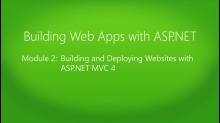 Building Web Apps with ASP.NET Jump Start: (02) Building and Deploying Websites with ASP.NET MVC 4
Building Web Apps with ASP.NET Jump Start: (02) Building and Deploying Websites with ASP.NET MVC 4
In this session the instructors go over ASP.NET MVC 4 and provide several demos on creating a new site; adding a model, controller and view, to using entity framework code first. Lastly they demo how to deploy to Windows Azure Web Sites.
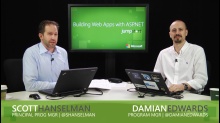 Building Web Apps with ASP.NET Jump Start: (03) Creating HTML5 Applications with jQuery
Building Web Apps with ASP.NET Jump Start: (03) Creating HTML5 Applications with jQuery
This module introduces you to the new standards of HTML5 and provides a demo of how powerful it is. Additionally you will see how it works with ASP.NET MVC 4, jQuery overview, Visual Studio Web Tools, Web Essentials and SPLA Template.
 Building Web Apps with ASP.NET Jump Start: (04) Building a Service Layer with ASP.NET Web API
Building Web Apps with ASP.NET Jump Start: (04) Building a Service Layer with ASP.NET Web API
Have you always want to know how to build a service layer with ASP.NET Web API? This segment shows how ASP.NET Web API fits in, and how to consume Web API from jQuery and Windows 8.
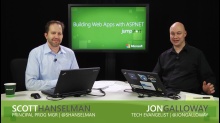 Building Web Apps with ASP.NET Jump Start: (05) Leveraging Your ASP.NET Development Skills to Build Office Apps
Building Web Apps with ASP.NET Jump Start: (05) Leveraging Your ASP.NET Development Skills to Build Office Apps
Get ready to see several Demos leveraging ASP.NET skills to build apps for Office specifically using HTML 5+ jQuery and ASP.NET Web API. This module will also go into further details regarding apps for Office and how they work. Using jQuery inside Office is freaky and cool.
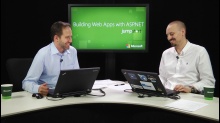 Building Web Apps with ASP.NET Jump Start: (06) Building and Leveraging Social Services in ASP.NET
Building Web Apps with ASP.NET Jump Start: (06) Building and Leveraging Social Services in ASP.NET
In this session you will see how to using social authentication with ASP.NET as well as an overview of the new Facebook application template.
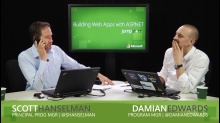 Building Web Apps with ASP.NET Jump Start: (07) Building for the Mobile Web
Building Web Apps with ASP.NET Jump Start: (07) Building for the Mobile Web
This module will provide and overview of adaptive rendering in ASP.NET 4.5 and ASP.NET MVC 4. This is especially important since mobile is fast becoming the primary way people browse the web. We'll also cover jQuery Mobile.
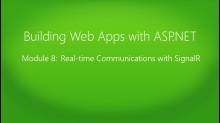 Building Web Apps with ASP.NET Jump Start: (08) Real-time Communication with SignalR
Building Web Apps with ASP.NET Jump Start: (08) Real-time Communication with SignalR
In this segment the instructors go over SignalR, and an incredibly simple real-time web for .NET. It will also provide an overview for real-time hit counter, what SignalR is and how to build a chat application, a multi-player game and load balancing SignalR.
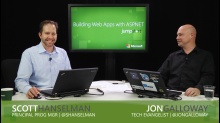 Building Web Apps with ASP.NET Jump Start: (09) Taking Advantage of Windows Azure Services
Building Web Apps with ASP.NET Jump Start: (09) Taking Advantage of Windows Azure Services
And where would we be if we could not scale it all up or down. This flexibility can be provided with Windows Azure. Here you will see how Windows Azure fits in with mobile services, virtual machines while managing caching and storage.
I hope you enjoy the day! Here's a complete course outline with jumps to specific spots:
Building Web Apps with ASP.NET Jump Start
- 1: What's New in ASP.NET 4.5
- 2: Building and Deploying Websites with ASP.NET MVC 4
- 3: Creating HTML5 Applications with jQuery
- 4: Building a Service Layer with ASP.NET Web API
- 5: Leveraging Your ASP.NET Development Skills to Build Office Apps
- 6: Building and Leveraging Social Services in ASP.NET
- 7: Building for the Mobile Web
- 8: Real-time Communication with SignalR
- 9: Taking Advantage of Windows Azure Services
If you’d like more information, including links to a lot of the sample code, see Jon’s wrap-up post.
Related Links
- Developing in HTML5 with JavaScript and CSS3 Jump Start
- Developing Windows Store Apps with HTML5 Jump Start
- Released: ASP.NET and Web Tools 2012.2 in Context
About Scott
Scott Hanselman is a former professor, former Chief Architect in finance, now speaker, consultant, father, diabetic, and Microsoft employee. He is a failed stand-up comic, a cornrower, and a book author.
About Newsletter
Have you looked at the SPA template? It's exactly what you're describing in your third sentence.
You might also look at SPA in Web Forms or using WebFormsMVP.
Thanks for reading my mind!
I'm not saying that I "have" to move to MVC to get Web API. Just that I saw an opportunity "in Web API" to try and program like MVC "in webforms". Currently I throw a div in a .aspx page call a .cshtml page to return the HTML. The .cshtml page is acting like an Controller / View. Instead of this method it would be great for Web API to act as the controller.
SPA is definitely a solid choice but many of our users are still running IE8. Using that heavy of javascript is kind of a risky at this point. However we are slowly moving towards a SPA application.
So in other words your saying. No Web API can not pass back a View() or Raw HTML?
So we will now have Web Forms, Web API, Web Pages, MVC and SignalR all running together.
Kinda crazy
After all, "there can be only one!" Or at least there should be ...
:)
I also get what Lynn and Mike (the other one) are talking about, the divergence, or diversity of the technologies available. But that's always been the way of development, as in many choices to achieve our goals.
Any chance of zipping the video's. Our company does not allow us to view/download any media files. If you zip, I will be able to download....please, please, please :)
Loved the presentations...watched it live....hope your throat is OK now
Cheers!
I had a really long winded response which I just scrapped as it seems I was voting for both options, but really it boils down to this: if you want to keep WebForms (understandable, we have a monolithic app built using it as well. That and I'm the only one who knows MVC.) but have the benefits of MVC, you're going to need to add either Web API or MVC.
While the general consensus would be to go Web API and do object-to-json-back-to-object, there really isn't a wrong answer here. Per your wants, of being able to return a View, I'd say go MVC and the reasoning is that MVC can also act as Web API: I have an Action in the MVC application I just completed whose single purpose is to return data that the View's select2 select box can consume via a GET call. The reason I went with that instead of the "I know that should probably be a Web API function" is simple (trust me, wanted to go that route): servers are given on a "you better need it" basis at work. And while that call is made quite frequently, I'm not going to be able to convince the people who give the okays that it is a necessary expenditure (tried on a similar scenario).
Were also running SQL Server Report Viewer. So we will always need Web Forms in some form.
What do you think of this approach?
http://weblogs.asp.net/fredriknormen/archive/2012/06/28/using-razor-together-with-asp-net-web-api.aspx
Very instructive.
I still like more the servicestack.net approach than the web.api one but i love to understand more, and web.api is the official way, which give it more chances to survive.
I also hope Mike gets his own message board :)
The videos were outstanding! Thanks for sticking with it and making it through because it was obvious that you weren't feeling well. Allow me to say that I thought the knowledge displayed by you & Damian Edwards was inspiring and both of you seemed to work well together. Looking forward to many more videos from you two.
I did have a question though: in the mobile video, you had a line of code in there to detect if the browser was a mobile browser and if the request was a get...if it was, then you displayed the view option that let the user flip back & forth between standard web view and mobile view. Later, you then created a .mobile version of that page and there was similar code in the top of it.
My reticence to create .mobile pages of web pages is that I now have the age-old problem of potentially maintaining code in 2 places going forward. Couldn't I have used the line of code to detect whether the browser was mobile or not? Then, based on that value, I could render mobile or web code accordingly? It seems that, while it might clutter the code for that page, it would seem infinitely more maintainable if someone other than myself picked up the code in the future.
Thanks again for the videos. Keep up the great work.
All these new features are great! The frustrating part is trying to make them do what they weren't designed for :)
I'll agree that Web API pumping data to your WebForms with whatever glue you so choose (knockout being your example) is a good way to go. If you ever add a mobile app (if it is a data dependent application, desktop would work as well), you've knocked out a good amount of development already.
For what it's worth MVC would be awesome for companies with more than one programmer. If I had a team there is no question I would use MVC.
Since I'm a sole developer it seems like the fastest way to get features out the door is Webpages.
Problem is that I don't have the time to spend on the infrastructure needed by MVC.
http://www.hanselminutes.com/249/on-webmatrix-with-rob-conery
Straight Webpages all the way
Successfully ported a small project from WebForms -> Web Pages -> MVC 4
Once I had it working with Web Pages then it was much easier to port to MVC 4.
The worst part about going from Web Forms to MVC is changing the coding style PLUS fragmenting the code.
Now for the big one! Let the 2 year saga continue......
Very similar to your SPA suggestion but more of a hybrid SPA not a full implementation.
For pages that we must use WebForms the plan is to use the new model binding features.
Thanks,
Mike
You can download them here. https://dl.dropbox.com/u/3380502/JumpStart%20Mid%20WMV.zip
Scott already mentioned this link above in his comment.
Looks like they also have free modeling and code generation tools at Xomega.NET that can generate most of the layers right from the domain and service models.
I'm glad there's now a focus on helping to educate existing .NET developers. I really dig it. Admittedly, independent study in tech is just tough. There's so much to absorb, and you never know if/when you'll need any of it. I know, I know, you guys have already filtered out the unimportant bits for me.
Thanks :)
Comments are closed.


Trying to migrate from Web Forms to MVC in the same project is just to much of an impediment.
Instead of having 4 CRUD .cshtml pages one could use 1 web api controller. Basically this would be attempt at doing MVC inside Web Forms. In other words use Web API as an HTML controller basically.
Some of us are so invested in Web Forms that it must be used. It would be nice to be able to code in an MVC'ish way alongside Web Forms without so much conflict.